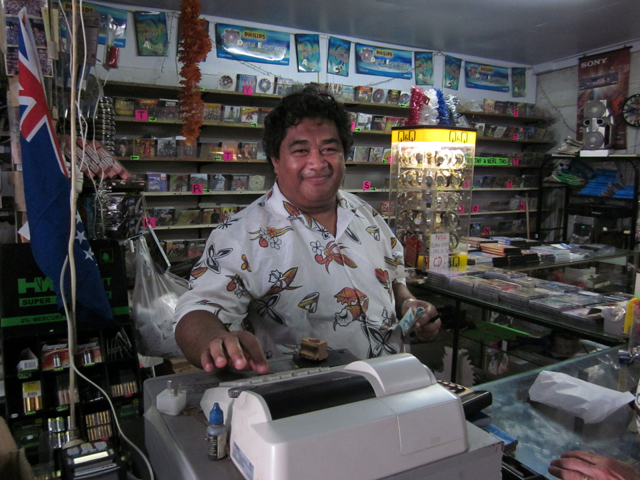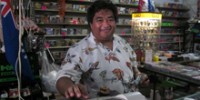By Stephen Palumbi, PhD.
“All out, sold out, all gone!” was the reply, “everybody bought one the day you did.” Meaning there was only one to begin with.
Coral reefs are dying off around the world. To further his work on the issue, Dr. Stephen Palumbi, director of Stanford’s Hopkins Marine Station, Pew Fellow in Marine Conservation, and OWOO Science Advisor is in American Samoa and the Cook Islands in search of the corals most likely to survive. This is the sixth in a series of special reports from the field that will continue throughout his team’s three-week expedition.
Part 1 Part 2 Part 3 Part 4 Part 5 Part 7
Rarotonga Records has everything for the coral scientist. In front of the store, racks of tourist clothing frame a chalked sign announcing that TVs are now $380. Inside, shelves stretch floor to ceiling with electronic parts, DVDs, extension cords, flip flops, and…voltage converters. I bought one here seven days ago to power the coral stress tank, and it failed to deliver enough power. Nonetheless, I cam back to try another one. We came here directly from the airport after returning to Rarotonga from Aitutaki – hoping to turn around the tank’s failure there.
“All out, sold out, all gone!” was the reply, “everybody bought one the day you did.”
Meaning there was only one to begin with. I knew no one else on Rarotonga sold voltage converters.
“None?” I asked, rather uselessly.
“None! All out!”
My mind started down the path to Plan C…how was I going to manage to run the tank? Then I heard, “Of course, there is that big one down there…but nobody ever wants that.”
“A big one?” I asked, “where?”

The savvy shopkeeper at Rarotonga Records. photo by Lauren Palumbi.
Down on the bottom shelf at the front of the store sat a hefty grey metal box with ‘Salvation’ written all over it. It was a machine-shop grade voltage converter and it’s heavy weight spoke of the hopefully huge transformer inside it. It’s weight and size told me I was never getting this box off the island, so I tried renting it for a week. No good, the savvy shop keeping saw a chance to sell something he’d kept (from the tarnish on the metal) on that lower shelf for years.
Fair enough. Sold. We carried it home to Paloma’s house near the Rarotonga Airport.
I cleared a spot on the countertop of the outdoor, tin-roofed picnic area that had seen many family beach barbeques. I restrained myself from going too fast, and I methodically set up the coral tank…LED lights, pump, heater, chillers, the micromanaging brain. I plugged them all into the new voltage converter, filled the tank with fresh water as a test, and carefully through the switch on the Big Volt Converter.
The brain woke up, flashing its normal indicator lights. The LEDs came on! The pump started! The chiller fired up! We had lift off – the tank was alive again!


A drenching downpour started immediately, and rainwater came through gaping holes in the tin roof, right over the outdoor electrical outlet and the stress tank! An electrical shock later, I was turning off the power to the main switch with a plastic-handled dish scrubber, and frantically gathering up the electronics to get them out of the rain. This was not the best way to start Rarotonga experiments on coral heat resistance, but all along I was very happy to have finally everything I needed.
Now if I can get the rainwater out of the voltage converter…







